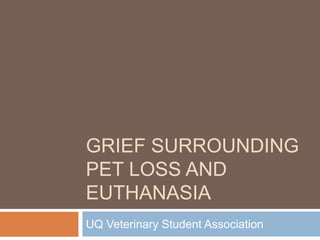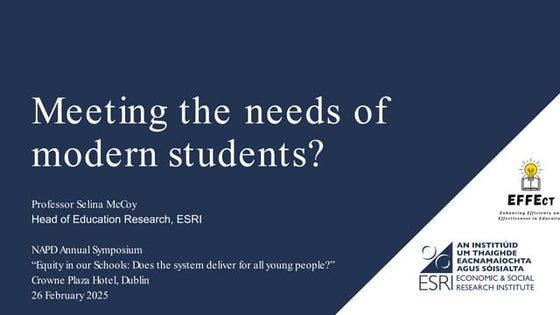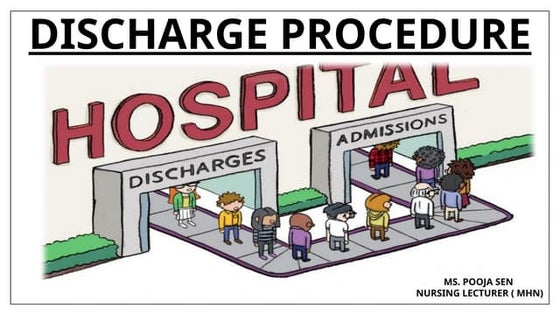Grief surrounding pet loss and euthanasia by Grace Harwood
Download as PPTX, PDF2 likes600 views
This document discusses grief surrounding pet loss and euthanasia. It defines key terms like loss, grief, bereavement and mourning. It outlines common responses to pet loss like feelings of sadness, anger and guilt. It notes that pet loss can be "disenfranchised grief" not openly acknowledged by others. The document provides advice on supporting children through pet loss and avoiding euphemisms when discussing euthanasia or death. It suggests what can help people cope with pet loss like being listened to, having their loss validated, and opportunities to ritualize or express their grief.
1 of 18
Downloaded 10 times


















Recommended
Separation, Grief and Loss



Separation, Grief and Lossuyvillage
╠²
Definition of Grief. Review of 5 stages of grief by Elisabeth Kubler-Ross. Ways we can help youth who are greiving. How to make separation or loss easier. Death and Dying 



Death and Dying Sheem Lawrence Fatallo
╠²
This document discusses various topics related to death, grief, mental illness, and mental disorders. It describes the five stages of grief following a loss (denial, anger, bargaining, depression, acceptance). It also differentiates between low-grief and high-grief deaths based on whether the death was anticipated. The document outlines some common mental disorders like mood disorders, bipolar disorder, schizophrenia, obsessive compulsive disorder, and posttraumatic stress disorder. It lists some early signs and symptoms of mental illness as well as preventive measures that can be taken.Loss and grief



Loss and griefkdcsdross
╠²
This document discusses loss, grief, and the grieving process. It defines grief as the natural reaction to an overwhelming loss, especially the loss of a loved one. The document outlines common types of loss people experience and myths about grief. It describes the five stages of grief as denial, anger, bargaining, depression, and acceptance, noting that not everyone experiences them in that order or at all. Finally, it provides tips for coping with grief, including finding support, taking care of physical health, and allowing oneself to feel all emotions without judgment.Separation, Grief and Loss of Children in Foster Care



Separation, Grief and Loss of Children in Foster Carekimberlykeith
╠²
Kimberly Keith, MEd, LPC
Academic Partnerships for Public Child Welfare
Department of Behavioral & Social Sciences
Southern Arkansas University
Magnolia, ArkansasCoping With the Holidays & COVID-19



Coping With the Holidays & COVID-19bkling
╠²
Women with ovarian cancer joined Julie Larson, LCSW and peers via video or phone to discuss "Coping With the Holidays & COVID-19."Grief, Loss & Separation Pwp Trandolph



Grief, Loss & Separation Pwp TrandolphPJoyceRandolph
╠²
This document discusses grief, loss, and separation experienced by child welfare workers. It notes that grief is painful and all-consuming, and can result from death, divorce, illness, aging, or job loss. It outlines several phases of grief according to theorists like Kubler-Ross and Westberg. These include shock, denial, anger, bargaining, depression, and acceptance. The document recommends acknowledging and processing grief through talking with others, self-care, and seeking counseling if needed. It stresses that grief takes time and energy to work through after painful losses.Presentation 208 a james durnil_ building blocks of resilience for professio...



Presentation 208 a james durnil_ building blocks of resilience for professio...The ALS Association
╠²
This document discusses building resilience for professional caregivers. It defines resilience as the ability to adapt to adversity while maintaining purpose, balance, and well-being. Key aspects of resilience include self-knowledge, humor, challenge perspective, acceptance, adaptability, and optimism. Developing resilience involves mindfulness, gratitude, meditation, and support from colleagues. The document recommends resources on stress management and developing resilience for healthcare professionals.Let's Talk About It: Ovarian Cancer - The Power of Traditions



Let's Talk About It: Ovarian Cancer - The Power of Traditionsbkling
╠²
The holiday season can be a time marked by family and seasonal traditions. Traditions can be comforting and centering in a way that helps us hold onto a sense of normalcy. But this time can also feel hard when the changes in your health seem more obvious compared to other times.
Join us as we talk together about embracing the holiday season with awareness for all the ways you might experience the weeks ahead.
Healing yourself3



Healing yourself3Manoel Gamas
╠²
In magnetic healing, spiritual assistance helps the patient heal themselves by addressing negative thoughts, feelings, and emotions that stem from past mistakes, guilt, and afflictions. The document discusses how shifting to positive thoughts, feelings, emotions, forgiveness, love, and faith can aid in self-healing.Assisting Children to Live with Death



Assisting Children to Live with DeathJohn C. "TC" Megahan
╠²
Adults must help children understand and accept their feelings about death by allowing them to mourn, say goodbye, express themselves, ask questions, and understand death is permanent but natural. Children's understanding of death progresses from seeing it as temporary to realizing it is irreversible and will happen to everyone. The mourning process takes time, with acute symptoms in the first few months and potential anniversary depression for years after.Presentation 218 sabrina schalley anticipatory grief in als families



Presentation 218 sabrina schalley anticipatory grief in als familiesThe ALS Association
╠²
This document discusses anticipatory grief experienced by families facing a terminal illness like ALS. It defines anticipatory grief as the grief felt in response to being aware of a life-threatening illness in oneself or a loved one. The document outlines factors that influence the intensity of anticipatory grief and common symptoms like sadness, fear, anxiety and guilt. It also discusses challenges like witnessing a loved one's decline and benefits like the ability to say goodbye. The document promotes normalizing grief and provides the EASE model for supporting families through education, assessment, support and exploring needs and strengths.Let's Talk About It: Ovarian Cancer - Cultivating Resilience



Let's Talk About It: Ovarian Cancer - Cultivating Resiliencebkling
╠²
Resilience is the ability to recover and adapt in the face of stress. Resilience is also a term that refers to a number of skills and characteristics that contribute to our ability to face hardship. Together we can work to name and strengthen the qualities that not only resonate but that you are discovering within yourself as you navigate cancer survivorship.Grief and bereavement



Grief and bereavementDheeraj Kattula
╠²
This presentation isn't going to give complete knowledge to the presenter. However it gives an idea of what topics to expound upon. This was made for third year medical students posted in a psychiatry department. It was presented over 45 minutes.The Good, The Bad and The Ugly: Relationships and Cancer



The Good, The Bad and The Ugly: Relationships and Cancerbkling
╠²
Women with ovarian cancer can join Julie Larson, LCSW and peers via video or phone to talk about topics such as "Relationships and Cancer."Loss And Grief



Loss And Griefpinoy nurze
╠²
The document discusses grief, loss, and the stages of grieving. It describes grief as a response to loss involving feelings, thoughts, and behaviors caused by bereavement. It outlines the stages of grieving according to Kubler-Ross as denial, anger, bargaining, depression, and acceptance. The stages of grieving by Kozier related to understanding of death at different ages are also presented. Nursing responsibilities in caring for those experiencing loss and death include providing relief from loneliness and fear, helping maintain a sense of security and control, and ensuring a dignified and peaceful death.Adolescence



AdolescenceDr. Riaz Ahmad Bhutta
╠²
The document discusses the key physical, psychological, and social changes that occur during adolescence. It describes the hormonal changes of puberty and their effects on physical development, mood, and sexual desires. It also addresses common problems adolescents face, like anxiety over physical changes, idealizing celebrities, experimenting sexually, and conflicts with parents over independence.Xv unit dying



Xv unit dyingShri Vinoba Bhave College of Nursing, Silvassa, Dadra & Nagar Haveli
╠²
The document provides information on caring for terminally ill patients, including concepts of loss, grief, and the grieving process. It discusses signs of clinical death and care for the dying patient, including psychological support, symptomatic management of breathing, eating/drinking, elimination, and immobility issues. Palliative care and hospice care are introduced as approaches that focus on comfort and quality of life for those facing life-threatening illness or end of life.Self-Injurious Behavior



Self-Injurious Behaviorfaulkss
╠²
This document discusses self-injurious behaviors (SIB), providing examples like cutting, substance abuse, and head-banging. SIB is defined as intentionally injuring one's body tissue without suicidal intent. It is described as a coping mechanism for difficult feelings like sadness or emptiness, though only a temporary solution. Those who engage in SIB often experience abuse, low self-esteem, and were discouraged from emotional expression. The document outlines signs of SIB and recommends treating students with respect, alternative outlets, and seeking medical help for severe cases.Presentation 214 b. bartja wachtel meaningful_the life practice of mindful ...



Presentation 214 b. bartja wachtel meaningful_the life practice of mindful ...The ALS Association
╠²
This document discusses cultivating mindfulness, compassion, and optimism for people living with ALS. It provides quotes from people with ALS about finding meaning and curiosity in their disease. It then outlines various assessments, practices, and strategies for developing eudaemonic well-being through higher purpose, community, self-compassion, relationships, meaning, and accomplishment rather than just hedonic happiness. These include cultivating optimism, mindfulness, self-compassion, gratitude, and giving back to others.Mental & emotional well being



Mental & emotional well beingJennifer Brenneman
╠²
Mental and Emotional Well-Being refers to an individual's overall condition in three areas: physical health which concerns the body's condition, mental health which involves the mind's condition and decision making, and social health which relates to the quality of relationships with others. Together these impact a person's quality of life.Talks on Mental Health



Talks on Mental HealthAanchal Garg
╠²
A simple and short presentation on being there for one another to fight against mental health disorders. I presented this to a community group of youth while leading a Mental Health Awareness Workshop conducted by an NGO based in New Delhi, India.Mandy Johnson: Unmasking co-dependency



Mandy Johnson: Unmasking co-dependencySACAP
╠²
Co-dependents grow up never having learned how to be themselves, or even what their true
identity really is. In adulthood this causes them to become over-identified with other people,
particular roles, jobs or professions. They basically focus on others problems to avoid having to
look at their own stuff. They try to change others ŌĆō they are those who are heard saying: ŌĆ£IŌĆÖd be
all right if only everybody else would changeŌĆØ. This talk gets to the heart of what this very
misunderstood process addiction is about.Case Study2



Case Study2gbrown
╠²
A middle-aged man comes to counseling reporting severe depression with disturbed eating and sleeping habits and thoughts of self-harm to end his misery. His symptoms include loss of interest, low energy, difficulty concentrating, and insomnia. The document discusses depression in men, causes of depression including genetics and stress, common symptoms, and treatment options including medication, psychotherapy, and family support provided with unconditional acceptance and empathy.Depression



Depressionguest469c12e
╠²
Depression is described as feeling sad, blue, unhappy, miserable, or down. Some signs of depression include feeling hopeless, loss of interest in activities, difficulties sleeping, excessive thinking about mistakes, and thoughts of suicide. Physical symptoms can include changes in appetite, fatigue, aches and pains, and feelings of emptiness. There are several types of depression including anxiety disorders, bipolar disorder, depression related to physical illness, and seasonal affective disorder. Rates of depression are increasing, with 15% of developed countries experiencing severe depression and 30% of women experiencing depression.Social Anxiety Disorder



Social Anxiety Disorderrachelcarolinemcpherson
╠²
Social Anxiety Disorder, also known as social phobia, is an intense fear or distress in social situations that can range from everyday interactions to performances. It affects 5% of adults in the US and Canada and 2.7% in Australia, with onset typically around age 11.5. Genetics play a role as shyness can lead to the disorder, and experiences like bullying can also contribute to its development. Lower levels of neurotransmitters like dopamine and serotonin as well as hypersensitivity in the amygdala and anterior cingulate cortex are neural factors. Treatment includes cognitive behavioral therapy and medication like SSRIs.Families and Chronic Pain



Families and Chronic PainLouise Stanger Ed.D, LCSW, CDWF, CIP
╠²
This document discusses chronic pain and its impact on families. It covers topics like what chronic pain is, how substance abuse and mental health issues can be intertwined, and the role of families. Families of those with chronic pain may experience isolation, loss of support systems, and increased daily stress. Chronic pain can disrupt relationships and become the organizing force in a family. The document also discusses trauma and its definitions, as well as qualitative inquiry methods like portraiture and family mapping. Several case examples are provided to illustrate challenges families face and potential treatment strategies.Unit 5 Part 4 Suicide



Unit 5 Part 4 Suicidemrodgersjps
╠²
The document discusses suicide among teens and provides statistics and warning signs. It notes that suicide is the 3rd leading cause of death for teens aged 15-24 and discusses common methods and risk periods. Warning signs that someone may be contemplating suicide include talking about death, giving away possessions, mood changes, and increased risk-taking. The best way for friends to help is to listen without judgment, ask if they have a plan, and get help from an adult.Social Anxiety Disorder



Social Anxiety Disorderguestb57e6c7
╠²
Social Anxiety Disorder (SAD) is characterized by a fear of humiliation in social situations which can cause panic attacks. It often runs in families biologically and can also stem from embarrassing past experiences psychologically. Physical symptoms include increased heart rate and sweating while mental symptoms are a fear of interactions, public speaking, and using public restrooms. Treatment involves cognitive behavioral therapy to change irrational thoughts, medication, and practicing social exposures.Chapter 9 Death & Dying2



Chapter 9 Death & Dying2bholmes
╠²
The document discusses loss, grief, dying and death. It covers topics such as the historical changes in end-of-life care, types of losses, grief and mourning processes, challenges with dysfunctional grief, stages of grief, and supportive nursing care for patients and families experiencing loss or end-of-life. It provides information on assessing physical, emotional, intellectual, social and spiritual needs during grieving or dying.Chapter 009



Chapter 009bholmes
╠²
This document provides an overview of concepts related to loss, grief, dying, and death. It discusses historical perspectives on end-of-life care; types of losses; the grief process; stages of grief; signs of dysfunctional grief; nursing assessments and roles in supporting the dying patient and grieving family; and special considerations around death, such as organ donation, advanced directives, and communicating with dying patients.More Related Content
What's hot (20)
Healing yourself3



Healing yourself3Manoel Gamas
╠²
In magnetic healing, spiritual assistance helps the patient heal themselves by addressing negative thoughts, feelings, and emotions that stem from past mistakes, guilt, and afflictions. The document discusses how shifting to positive thoughts, feelings, emotions, forgiveness, love, and faith can aid in self-healing.Assisting Children to Live with Death



Assisting Children to Live with DeathJohn C. "TC" Megahan
╠²
Adults must help children understand and accept their feelings about death by allowing them to mourn, say goodbye, express themselves, ask questions, and understand death is permanent but natural. Children's understanding of death progresses from seeing it as temporary to realizing it is irreversible and will happen to everyone. The mourning process takes time, with acute symptoms in the first few months and potential anniversary depression for years after.Presentation 218 sabrina schalley anticipatory grief in als families



Presentation 218 sabrina schalley anticipatory grief in als familiesThe ALS Association
╠²
This document discusses anticipatory grief experienced by families facing a terminal illness like ALS. It defines anticipatory grief as the grief felt in response to being aware of a life-threatening illness in oneself or a loved one. The document outlines factors that influence the intensity of anticipatory grief and common symptoms like sadness, fear, anxiety and guilt. It also discusses challenges like witnessing a loved one's decline and benefits like the ability to say goodbye. The document promotes normalizing grief and provides the EASE model for supporting families through education, assessment, support and exploring needs and strengths.Let's Talk About It: Ovarian Cancer - Cultivating Resilience



Let's Talk About It: Ovarian Cancer - Cultivating Resiliencebkling
╠²
Resilience is the ability to recover and adapt in the face of stress. Resilience is also a term that refers to a number of skills and characteristics that contribute to our ability to face hardship. Together we can work to name and strengthen the qualities that not only resonate but that you are discovering within yourself as you navigate cancer survivorship.Grief and bereavement



Grief and bereavementDheeraj Kattula
╠²
This presentation isn't going to give complete knowledge to the presenter. However it gives an idea of what topics to expound upon. This was made for third year medical students posted in a psychiatry department. It was presented over 45 minutes.The Good, The Bad and The Ugly: Relationships and Cancer



The Good, The Bad and The Ugly: Relationships and Cancerbkling
╠²
Women with ovarian cancer can join Julie Larson, LCSW and peers via video or phone to talk about topics such as "Relationships and Cancer."Loss And Grief



Loss And Griefpinoy nurze
╠²
The document discusses grief, loss, and the stages of grieving. It describes grief as a response to loss involving feelings, thoughts, and behaviors caused by bereavement. It outlines the stages of grieving according to Kubler-Ross as denial, anger, bargaining, depression, and acceptance. The stages of grieving by Kozier related to understanding of death at different ages are also presented. Nursing responsibilities in caring for those experiencing loss and death include providing relief from loneliness and fear, helping maintain a sense of security and control, and ensuring a dignified and peaceful death.Adolescence



AdolescenceDr. Riaz Ahmad Bhutta
╠²
The document discusses the key physical, psychological, and social changes that occur during adolescence. It describes the hormonal changes of puberty and their effects on physical development, mood, and sexual desires. It also addresses common problems adolescents face, like anxiety over physical changes, idealizing celebrities, experimenting sexually, and conflicts with parents over independence.Xv unit dying



Xv unit dyingShri Vinoba Bhave College of Nursing, Silvassa, Dadra & Nagar Haveli
╠²
The document provides information on caring for terminally ill patients, including concepts of loss, grief, and the grieving process. It discusses signs of clinical death and care for the dying patient, including psychological support, symptomatic management of breathing, eating/drinking, elimination, and immobility issues. Palliative care and hospice care are introduced as approaches that focus on comfort and quality of life for those facing life-threatening illness or end of life.Self-Injurious Behavior



Self-Injurious Behaviorfaulkss
╠²
This document discusses self-injurious behaviors (SIB), providing examples like cutting, substance abuse, and head-banging. SIB is defined as intentionally injuring one's body tissue without suicidal intent. It is described as a coping mechanism for difficult feelings like sadness or emptiness, though only a temporary solution. Those who engage in SIB often experience abuse, low self-esteem, and were discouraged from emotional expression. The document outlines signs of SIB and recommends treating students with respect, alternative outlets, and seeking medical help for severe cases.Presentation 214 b. bartja wachtel meaningful_the life practice of mindful ...



Presentation 214 b. bartja wachtel meaningful_the life practice of mindful ...The ALS Association
╠²
This document discusses cultivating mindfulness, compassion, and optimism for people living with ALS. It provides quotes from people with ALS about finding meaning and curiosity in their disease. It then outlines various assessments, practices, and strategies for developing eudaemonic well-being through higher purpose, community, self-compassion, relationships, meaning, and accomplishment rather than just hedonic happiness. These include cultivating optimism, mindfulness, self-compassion, gratitude, and giving back to others.Mental & emotional well being



Mental & emotional well beingJennifer Brenneman
╠²
Mental and Emotional Well-Being refers to an individual's overall condition in three areas: physical health which concerns the body's condition, mental health which involves the mind's condition and decision making, and social health which relates to the quality of relationships with others. Together these impact a person's quality of life.Talks on Mental Health



Talks on Mental HealthAanchal Garg
╠²
A simple and short presentation on being there for one another to fight against mental health disorders. I presented this to a community group of youth while leading a Mental Health Awareness Workshop conducted by an NGO based in New Delhi, India.Mandy Johnson: Unmasking co-dependency



Mandy Johnson: Unmasking co-dependencySACAP
╠²
Co-dependents grow up never having learned how to be themselves, or even what their true
identity really is. In adulthood this causes them to become over-identified with other people,
particular roles, jobs or professions. They basically focus on others problems to avoid having to
look at their own stuff. They try to change others ŌĆō they are those who are heard saying: ŌĆ£IŌĆÖd be
all right if only everybody else would changeŌĆØ. This talk gets to the heart of what this very
misunderstood process addiction is about.Case Study2



Case Study2gbrown
╠²
A middle-aged man comes to counseling reporting severe depression with disturbed eating and sleeping habits and thoughts of self-harm to end his misery. His symptoms include loss of interest, low energy, difficulty concentrating, and insomnia. The document discusses depression in men, causes of depression including genetics and stress, common symptoms, and treatment options including medication, psychotherapy, and family support provided with unconditional acceptance and empathy.Depression



Depressionguest469c12e
╠²
Depression is described as feeling sad, blue, unhappy, miserable, or down. Some signs of depression include feeling hopeless, loss of interest in activities, difficulties sleeping, excessive thinking about mistakes, and thoughts of suicide. Physical symptoms can include changes in appetite, fatigue, aches and pains, and feelings of emptiness. There are several types of depression including anxiety disorders, bipolar disorder, depression related to physical illness, and seasonal affective disorder. Rates of depression are increasing, with 15% of developed countries experiencing severe depression and 30% of women experiencing depression.Social Anxiety Disorder



Social Anxiety Disorderrachelcarolinemcpherson
╠²
Social Anxiety Disorder, also known as social phobia, is an intense fear or distress in social situations that can range from everyday interactions to performances. It affects 5% of adults in the US and Canada and 2.7% in Australia, with onset typically around age 11.5. Genetics play a role as shyness can lead to the disorder, and experiences like bullying can also contribute to its development. Lower levels of neurotransmitters like dopamine and serotonin as well as hypersensitivity in the amygdala and anterior cingulate cortex are neural factors. Treatment includes cognitive behavioral therapy and medication like SSRIs.Families and Chronic Pain



Families and Chronic PainLouise Stanger Ed.D, LCSW, CDWF, CIP
╠²
This document discusses chronic pain and its impact on families. It covers topics like what chronic pain is, how substance abuse and mental health issues can be intertwined, and the role of families. Families of those with chronic pain may experience isolation, loss of support systems, and increased daily stress. Chronic pain can disrupt relationships and become the organizing force in a family. The document also discusses trauma and its definitions, as well as qualitative inquiry methods like portraiture and family mapping. Several case examples are provided to illustrate challenges families face and potential treatment strategies.Unit 5 Part 4 Suicide



Unit 5 Part 4 Suicidemrodgersjps
╠²
The document discusses suicide among teens and provides statistics and warning signs. It notes that suicide is the 3rd leading cause of death for teens aged 15-24 and discusses common methods and risk periods. Warning signs that someone may be contemplating suicide include talking about death, giving away possessions, mood changes, and increased risk-taking. The best way for friends to help is to listen without judgment, ask if they have a plan, and get help from an adult.Social Anxiety Disorder



Social Anxiety Disorderguestb57e6c7
╠²
Social Anxiety Disorder (SAD) is characterized by a fear of humiliation in social situations which can cause panic attacks. It often runs in families biologically and can also stem from embarrassing past experiences psychologically. Physical symptoms include increased heart rate and sweating while mental symptoms are a fear of interactions, public speaking, and using public restrooms. Treatment involves cognitive behavioral therapy to change irrational thoughts, medication, and practicing social exposures.Similar to Grief surrounding pet loss and euthanasia by Grace Harwood (20)
Chapter 9 Death & Dying2



Chapter 9 Death & Dying2bholmes
╠²
The document discusses loss, grief, dying and death. It covers topics such as the historical changes in end-of-life care, types of losses, grief and mourning processes, challenges with dysfunctional grief, stages of grief, and supportive nursing care for patients and families experiencing loss or end-of-life. It provides information on assessing physical, emotional, intellectual, social and spiritual needs during grieving or dying.Chapter 009



Chapter 009bholmes
╠²
This document provides an overview of concepts related to loss, grief, dying, and death. It discusses historical perspectives on end-of-life care; types of losses; the grief process; stages of grief; signs of dysfunctional grief; nursing assessments and roles in supporting the dying patient and grieving family; and special considerations around death, such as organ donation, advanced directives, and communicating with dying patients.Pet Bereavement Support: Loss and Grief



Pet Bereavement Support: Loss and GriefJulia Dando (Julala Jinx)
╠²
This document summarizes a webinar on pet bereavement support that discusses loss and grief. It covers terminology related to bereavement and grief, factors that influence grief, and how grief affects people physically, cognitively, psychologically, and socially. It also discusses anticipatory grief and responsibility grief. The webinar explores people's experiences with pet loss and offers future webinars on introducing a pet bereavement support service, providing support to the bereaved, and developing support protocols.Death and dying



Death and dyingChantal Settley
╠²
The document discusses several topics related to death and dying:
- It outlines the stages of death and dying according to K├╝bler-Ross (denial, anger, bargaining, depression, acceptance).
- It examines common fears associated with death like suffering, isolation, and the death of loved ones.
- It explores palliative care which aims to relieve suffering for seriously ill patients.
- Cultural differences in views on death and grief are noted.
- The definition of death from a physiological perspective is provided.Death and dying-1



Death and dying-1University of Miami
╠²
This document discusses various topics related to death and dying, including definitions, the stages of dying, fears patients may experience, how to talk to patients and their families, hospice care, and advanced directives. It defines terms like terminally ill and imminently dying. It outlines the stages of dying as denial, anger, bargaining, depression and acceptance. It provides guidance on discussing death with patients, addressing their fears, and responding to grieving families. It also describes hospice services and the interdisciplinary team that provides end-of-life care.Missing Persons and Ambiguous Loss - Supporting Families Apr 17 2019



Missing Persons and Ambiguous Loss - Supporting Families Apr 17 2019Maureen Trask
╠²
Presentation to volunteers and staff at Victim Assistance Services of Oxford County (VASOC) on Apr. 17, 2019Helping Children Cope with Grief and Loss: A Guide for Caregivers



Helping Children Cope with Grief and Loss: A Guide for CaregiversKaitlynJones26
╠²
This is a guide my group created to be used by Shani Thornton, a registered CCLS in California. This guide walks caregivers through the difficult task of navigating their child's experience with grief while giving information on how to talk to the child, developmentally appropriate responses to loss, and a list of children's books that may be helpful in guiding their child. 1selvaraj



1selvarajselvaraj227
╠²
AUTUMN OF LIFE-A LAST GASP-LOSS, GRIEF AND
END- OF- LIFE
MASLOW'S HIERARCHY, ANTICIPATORY GRIEF, DIMENSION OF GRIEVING, GRIEF AWARENESS, Five Wishes, NEEDS OF DYING PERSONS AND SURVIVORSMissing Persons and Ambiguous Loss - Supporting Families Oct 2 2018



Missing Persons and Ambiguous Loss - Supporting Families Oct 2 2018Maureen Trask
╠²
Presentation for Staff, Team Leaders and Volunteers of Victim Services, Haldimand-Norfolk, New Credit.Dart Unit 11 Psychology



Dart Unit 11 PsychologyusDART
╠²
- The document discusses the psychological impacts of disasters and emergencies on survivors and rescuers. It describes common reactions survivors may experience such as shock, grief, and post-traumatic stress as well as ways rescuers can help survivors cope.
- Rescuers are also at risk of experiencing vicarious trauma and should monitor their own stress levels, communicate with others, and ensure adequate self-care including rest.
- The loss of companion and livestock animals can also cause intense grief for owners, and rescuers should handle deceased animals respectfully and allow owners time to grieve.Anything Most Updated Ppt 2011



Anything Most Updated Ppt 2011bjrcurrie
╠²
This document provides guidance for educators on supporting students dealing with grief, loss, trauma, and other difficult experiences. It discusses types of loss students may face, how loss can affect them, strategies for addressing common reactions, and ideas for classroom activities and memorials. Key recommendations include listening without judgment, maintaining routines, acknowledging emotions, and connecting grieving students to support networks.Grief, Loss,Death And Dying



Grief, Loss,Death And Dyingmarianects
╠²
The document discusses various topics related to loss, grief, and the dying process. It describes how grief involves a sequence of emotional, cognitive, and psychological responses to loss. It outlines common stages in the grieving process including denial, anger, bargaining, depression, and acceptance. It also discusses physical, psychological, social, and spiritual needs of the dying, including the role of healthcare providers in providing support and a peaceful end of life experience.Missing Persons and Ambiguous Loss - Supporting Families May 29 2018



Missing Persons and Ambiguous Loss - Supporting Families May 29 2018Maureen Trask
╠²
This presentation discusses supporting families of missing persons who experience ambiguous loss. It defines ambiguous loss as when a person is physically absent but psychologically present, or vice versa. The presenter outlines the needs of families, including being heard and understanding support systems. Ambiguous loss freezes the grief process and impacts family functioning. The presentation recommends services provide crisis intervention, emotional support, and help families navigate uncertainty. It stresses the importance of listening to families and empowering them to cope with ambiguous loss.End of-life care



End of-life careSheila Marie Oconer
╠²
This document discusses various aspects of end-of-life care including communicating bad news, managing symptoms, types of pain, loss and grief, components of a peaceful death, and postmortem care. It emphasizes the nurse's role in ensuring patients have a good death free from avoidable suffering by properly assessing and treating physical and psychological symptoms, respecting patient wishes, and supporting families through the dying process. The document provides guidance on steps to take when pronouncing death and caring for the deceased's body in a gentle, respectful manner.Case of death and dying, meaning and it's management.pptx



Case of death and dying, meaning and it's management.pptxSanchitSharma619501
╠²
Case of death and dying, meaning and it's management.VSWR Training Nov 14 2022.pptx



VSWR Training Nov 14 2022.pptxMaureen Trask
╠²
This document outlines a volunteer training session on supporting families with missing persons. It discusses exploring the concept of "missing", learning about ambiguous loss and the supports needed by families. It emphasizes listening to families, understanding their experiences with uncertainty and triggers, and providing emotional support and referrals. It also discusses the need for improved relationships between police and families, and how victim services can help families navigate systems and resources during their journey.5. death and dying f



5. death and dying fBP KOIRALA INSTITUTE OF HELATH SCIENCS,, NEPAL
╠²
The document discusses care of the dying individual. It begins with an introduction to death and dying, including definitions of death and dying. It then outlines the 5 stages of dying according to Kubler-Ross: denial, anger, bargaining, depression, and acceptance. The stages are described in detail. The document also discusses assessing the physiological signs of approaching death and providing physical, psychological, social, and spiritual care for the dying individual. It emphasizes meeting the patient's needs, maintaining communication, and allowing for dignity in death.PSYCHOLOGICAL FIRST AID - Presentation Version.pptx



PSYCHOLOGICAL FIRST AID - Presentation Version.pptxabhyaatime
╠²
This document provides information on psychological first aid (PFA). It defines PFA as the humane and supportive care given to individuals who have experienced distressing events to help reduce initial distress and foster adaptive coping. PFA is not counseling but involves assessing needs, listening non-judgmentally, comforting people, and linking them to services and social supports. The document outlines common crisis reactions like shock, anxiety, and guilt. It emphasizes delivering PFA with cultural sensitivity and protecting privacy. Effective PFA involves looking around to ensure safety, listening to understand needs, and linking people to resources using a calm and respectful approach.Coping with GSD: What's the Secret



Coping with GSD: What's the Secretgsdlife
╠²
Presentation by Lisa Merla, Ph.D., M.P.E.
University of Florida
Department of Psychiatry
Outlines the daily challenges of GSD and ways to adaptively cope with them.
Presented at the 2010 GSD Conference in Orlando Florida
see www.GSDLife.org for more info...End of-life care



End of-life careSheila Marie Oconer
╠²
The document discusses various aspects of end-of-life care including communicating bad news, managing symptoms, providing comfort, and ensuring a peaceful death. It notes that less than 10% of people die suddenly while 90% experience a prolonged illness. It provides steps for communicating bad news to patients and families, describes approaches to managing common physical and psychological symptoms experienced by dying patients, and emphasizes the nurse's role in coordinating care and advocating for a dignified death without unnecessary suffering.Recently uploaded (20)
RRB ALP CBT 2 RAC Question Paper MCQ (Railway Assistant Loco Pilot)



RRB ALP CBT 2 RAC Question Paper MCQ (Railway Assistant Loco Pilot)SONU HEETSON
╠²
RRB ALP CBT 2 RAC Question Paper MCQ PDF Free Download. Railway Assistant Loco Pilot Mechanic Refrigeration and Air Conditioning Important Questions.Meeting the needs of modern students?, Selina McCoy



Meeting the needs of modern students?, Selina McCoyEconomic and Social Research Institute
╠²
NAPD Annual Symposium
ŌĆ£Equity in our Schools: Does the system deliver for all young people?ŌĆØNUTRITIONAL ASSESSMENT AND EDUCATION - 5TH SEM.pdf



NUTRITIONAL ASSESSMENT AND EDUCATION - 5TH SEM.pdfDolisha Warbi
╠²
NUTRITIONAL ASSESSMENT AND EDUCATION, Introduction, definition, types - macronutrient and micronutrient, food pyramid, meal planning, nutritional assessment of individual, family and community by using appropriate method, nutrition education, nutritional rehabilitation, nutritional deficiency disorder, law/policies regarding nutrition in India, food hygiene, food fortification, food handling and storage, food preservation, food preparation, food purchase, food consumption, food borne diseases, food poisoningInterim Guidelines for PMES-DM-17-2025-PPT.pptx



Interim Guidelines for PMES-DM-17-2025-PPT.pptxsirjeromemanansala
╠²
This is the latest issuance on PMES as replacement of RPMS. Kindly message me to gain full access of the presentation. Entity Framework Interview Questions PDF By ScholarHat



Entity Framework Interview Questions PDF By ScholarHatScholarhat
╠²
Entity Framework Interview Questions PDF By ScholarHatUnit 1 Computer Hardware for Educational Computing.pptx



Unit 1 Computer Hardware for Educational Computing.pptxRomaSmart1
╠²
Computers have revolutionized various sectors, including education, by enhancing learning experiences and making information more accessible. This presentation, "Computer Hardware for Educational Computing," introduces the fundamental aspects of computers, including their definition, characteristics, classification, and significance in the educational domain. Understanding these concepts helps educators and students leverage technology for more effective learning.Bß╗ś TEST KIß╗éM TRA GIß╗«A K├ī 2 - TIß║ŠNG ANH 10,11,12 - CHUß║©N FORM 2025 - GLOBAL SU...



Bß╗ś TEST KIß╗éM TRA GIß╗«A K├ī 2 - TIß║ŠNG ANH 10,11,12 - CHUß║©N FORM 2025 - GLOBAL SU...Nguyen Thanh Tu Collection
╠²
https://app.box.com/s/ij1ty3vm7el9i4qfrr41o756xycbahmgHow to create security group category in Odoo 17



How to create security group category in Odoo 17Celine George
╠²
This slide will represent the creation of security group category in odoo 17. Security groups are essential for managing user access and permissions across different modules. Creating a security group category helps to organize related user groups and streamline permission settings within a specific module or functionality.Year 10 The Senior Phase Session 3 Term 1.pptx



Year 10 The Senior Phase Session 3 Term 1.pptxmansk2
╠²
Year 10 The Senior Phase Session 3 Term 1.pptxASP.NET Interview Questions PDF By ScholarHat



ASP.NET Interview Questions PDF By ScholarHatScholarhat
╠²
ASP.NET Interview Questions PDF By ScholarHatAzure Administrator Interview Questions By ScholarHat



Azure Administrator Interview Questions By ScholarHatScholarhat
╠²
Azure Administrator Interview Questions By ScholarHatDot NET Core Interview Questions PDF By ScholarHat



Dot NET Core Interview Questions PDF By ScholarHatScholarhat
╠²
Dot NET Core Interview Questions PDF By ScholarHatHow to Configure Recurring Revenue in Odoo 17 CRM



How to Configure Recurring Revenue in Odoo 17 CRMCeline George
╠²
This slide will represent how to configure Recurring revenue. Recurring revenue are the income generated at a particular interval. Typically, the interval can be monthly, yearly, or we can customize the intervals for a product or service based on its subscription or contract. Bß╗ś TEST KIß╗éM TRA GIß╗«A K├ī 2 - TIß║ŠNG ANH 10,11,12 - CHUß║©N FORM 2025 - GLOBAL SU...



Bß╗ś TEST KIß╗éM TRA GIß╗«A K├ī 2 - TIß║ŠNG ANH 10,11,12 - CHUß║©N FORM 2025 - GLOBAL SU...Nguyen Thanh Tu Collection
╠²
Grief surrounding pet loss and euthanasia by Grace Harwood
- 1. Grief Surrounding Pet Loss and EuthanasiaUQ Veterinary Student Association
- 2. Grace HarwoodBSoc Sc (Pastoral Counselling), BTh, MACA, MFPCQ, CCAA (Grad)Ipswich Hospice Care IncManager of HildaŌĆÖs HouseBereavement Support ŌĆō pre and post death
- 3. What would you like to know?What would you like to walk away from this session with?
- 4. Our own experiences:Have you had an animal die?When you think back to this time:What was helpful?What would you do differently?
- 5. When you think about this topic, what worries or concerns you most?
- 6. Euthanasing:When ŌĆō When is the right time? Why ŌĆō What is the ownerŌĆÖs motivation? How do we feel about it?Who ŌĆō Who will be present? Do they understand the process? Will you be able to give them an opportunity to say goodbye?Where ŌĆō Where and when will it take place? Where will the body go?How ŌĆō How will it take place? How do we handle it? How do we negotiate payment?
- 8. DefinitionsLOSS:To be deprived of someone or something that holds great meaning.GRIEF: all the emotions and physical responses both surrounding and related to the lossBEREAVEMENT:The journey in which one experiences griefMOURNING:The outward expression of the loss we have experienced ŌĆō eg rituals, clothing, candles, roadside signs etc
- 9. Common Problems with Pet LossDisenfranchised GriefThis is the grief associated with a loss that is not:Openly acknowledgedPublicly mournedSocially supported
- 10. Common responses to griefFEELINGSSadnessAngerGuiltAnxietyLonelinessYearningFatigueHelplessnessShockNumbnessRelief DepressionRegretAbandonment BEHAVIOURSSleep disturbanceOver-activitySighingRestlessness Absent-mindednessAppetite disturbanceSocial withdrawlCryingDreams of the deceasedLack of concentrationRegression
- 11. Common responses to griefTHOUGHTSDisbeliefConfusionPre-occupationSense of presenceHallucinationsPHYSICAL SENSATIONSHollowness in the stomachOversensitivity to noiseTightness in the chest and throatDry mouthWeakness in musclesFatigueBreathlessnessLack of energy
- 12. Impact of Other LossesA previous significant loss can exacerbate the loss of a pet.The loss of a pet can involve secondary losses.Early losses in childhood are considered highly significant contributors to the likely success of the integration of later losses.Murray, 2006
- 13. ChildrenŌĆÖs GriefShould children be present at euthanasing?
- 14. ChildrenŌĆÖs Grief: What do they need?ReassuranceInformation and honest answersPatience and supportTime to adjustRoutines and stabilityLanguage which is understoodPeople who accept and a place to express their emotionsAdapted from Brown. 2001
- 15. Hint: Avoid EuphemismsSnuffed outKicked the bucketGone to sleepTaken by JesusPassed away/onPopped his clogsCrossed overPushing up daisiesLostGone to meet his makerPut him/her downGone to the happy hunting groundŌĆ”ŌĆ”
- 16. What helps people who have lost a pet?Being listened toBeing believed about their relationship with their petHaving their loss validatedHaving an opportunity to express the depth of their lossOpportunities to ritualise the lossLinking with others who have experienced similar lossesCounselling/support
- 17. Services you could provide:Sympathy cardReferral to pet burial/cremation servicesReferral to counselling/supportBrochures about Pet Loss and GriefŌĆ”ŌĆ”
Editor's Notes
- #6: ??Angry people ŌĆō displaced angerDistressed people
- #13: Dad and Caleb
- #14: What does the child want?Staff ŌĆō make it the best possible processFamilies/staff ŌĆō explain what will happenRemember age appropriate responses ŌĆō 8 year old boys are often much more interested I what will happen to the body once it is in the ground that the actual dying experience






